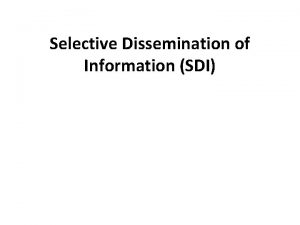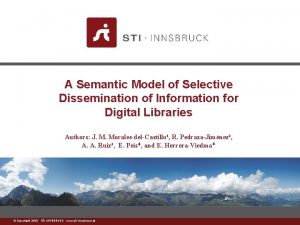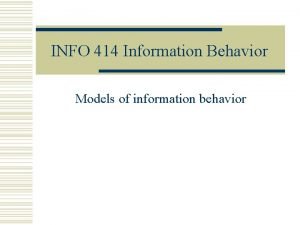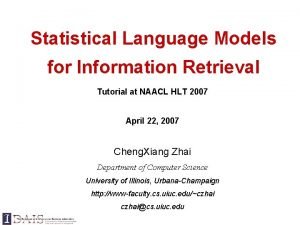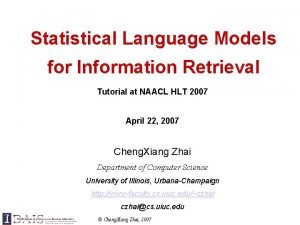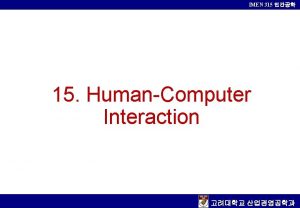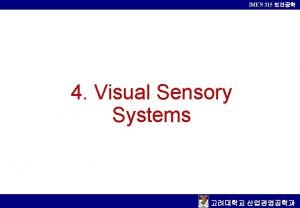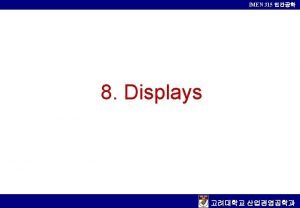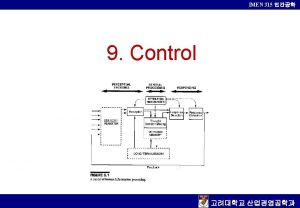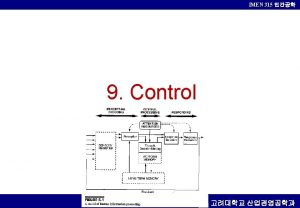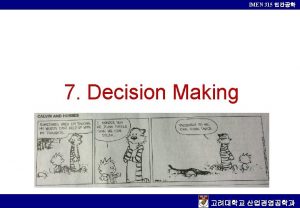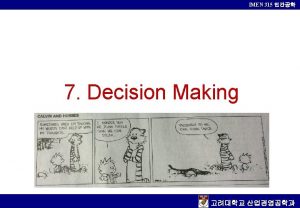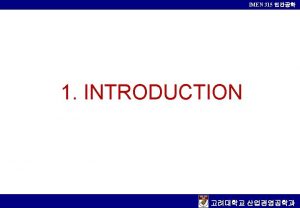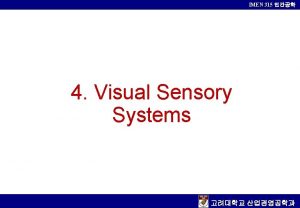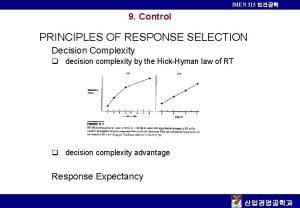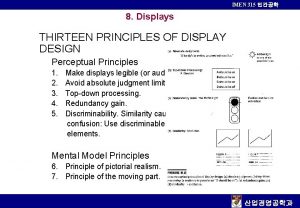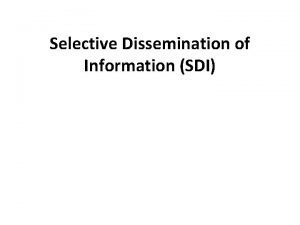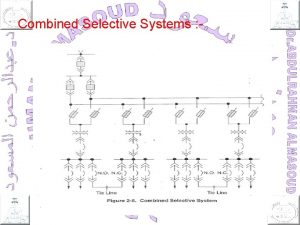IMEN 315 INFORMATION PROCESSING MODELS IMEN 315 SELECTIVE
























- Slides: 24


IMEN 315 인간공학 INFORMATION PROCESSING MODELS 고려대학교 산업경영공학과


IMEN 315 인간공학 SELECTIVE ATTENTION 고려대학교 산업경영공학과

IMEN 315 인간공학 q. Change blindness q. Inattentional blindness 고려대학교 산업경영공학과


IMEN 315 인간공학 q. Three Perceptual Processes 1) Bottom-up feature analysis 2) Unitization 3) Top-down processing Turn the machine off when the red light on!! 고려대학교 산업경영공학과

IMEN 315 인간공학 q. Human Factors Guidelines 1. Maximize bottom-up processing 2. Maximize automaticity and unitization 3. Maximize top-down processing when bottom-up processing may be poor, and when unitization may be missing 고려대학교 산업경영공학과


IMEN 315 인간공학 q. A Model of Working Memory q. Limits of Working Memory 1. Capacity 2. Time 3. Confusability and Similarity 4. Attention and Similarity 고려대학교 산업경영공학과

IMEN 315 인간공학 q. HF Implications of WM Limits 1. Minimize working memory load 2. Provide visual echoes 3. Provide placeholders for sequential tasks 4. Exploit chunking 5. Minimize confusability 6. Avoid unnecessary zeros in codes to be remembered 7. Consider WM limits in instructions 고려대학교 산업경영공학과


IMEN 315 인간공학 q. Basic Mechanisms q. Strength q. Associations q. WM and LTM q. Forgetting 고려대학교 산업경영공학과

IMEN 315 인간공학 q. Organization of Info in LTM q. Semantic Network q. Schemas and Scripts q. Mental Models q. Cognitive Maps 고려대학교 산업경영공학과

IMEN 315 인간공학 q. LTM Implications for Design 1. Encourage regular use of information to increase frequency and recency 2. Encourage active verbalization or reproduction of information to be recalled 3. Standardize 4. Use memory aids 5. Carefully design info to be remembered 6. Design to support development of correct mental models 고려대학교 산업경영공학과

IMEN 315 인간공학 q. Episodic Memory for Events q. Prospective Memory for Future Events 고려대학교 산업경영공학과

IMEN 315 인간공학 SITUATION AWARENESS 고려대학교 산업경영공학과

IMEN 315 인간공학 PROBLEM SOLVING AND TROUBLESHOOTING 고려대학교 산업경영공학과

IMEN 315 인간공학 PLANNING AND SCHEDULING 고려대학교 산업경영공학과

IMEN 315 인간공학 METACOGNITION AND EFFORT 고려대학교 산업경영공학과

IMEN 315 인간공학 ATTENTION AND TIMESHARING 고려대학교 산업경영공학과

IMEN 315 인간공학 q. Mental Effort and Resource Demand 고려대학교 산업경영공학과

IMEN 315 인간공학 q. Structural Similarity 고려대학교 산업경영공학과

IMEN 315 인간공학 q. Confusion q. Task Management and Interruptions q. Addressing Time-Sharing Overload 고려대학교 산업경영공학과
 Every february across the country candy flowers
Every february across the country candy flowers Propranolol side effect
Propranolol side effect Importance of selective dissemination of information
Importance of selective dissemination of information Components of selective dissemination of information
Components of selective dissemination of information What is the difference between model and semi modals
What is the difference between model and semi modals Image compression models in digital image processing
Image compression models in digital image processing Top down vs bottom up processing
Top down vs bottom up processing Gloria suarez
Gloria suarez Bottom up processing example
Bottom up processing example Neighborhood processing
Neighborhood processing What is secondary processing
What is secondary processing Point processing in image processing example
Point processing in image processing example Histogram processing in digital image processing
Histogram processing in digital image processing Parallel processing vs concurrent processing
Parallel processing vs concurrent processing Neighborhood processing in digital image processing
Neighborhood processing in digital image processing Point processing
Point processing Morphological processing in digital image processing
Morphological processing in digital image processing Top bottom processing
Top bottom processing What is interactive processing
What is interactive processing Information behavior models
Information behavior models Statistical language models for information retrieval
Statistical language models for information retrieval M.i.a.
M.i.a. Statistical language models for information retrieval
Statistical language models for information retrieval Isa 315 revised
Isa 315 revised Isa315
Isa315


